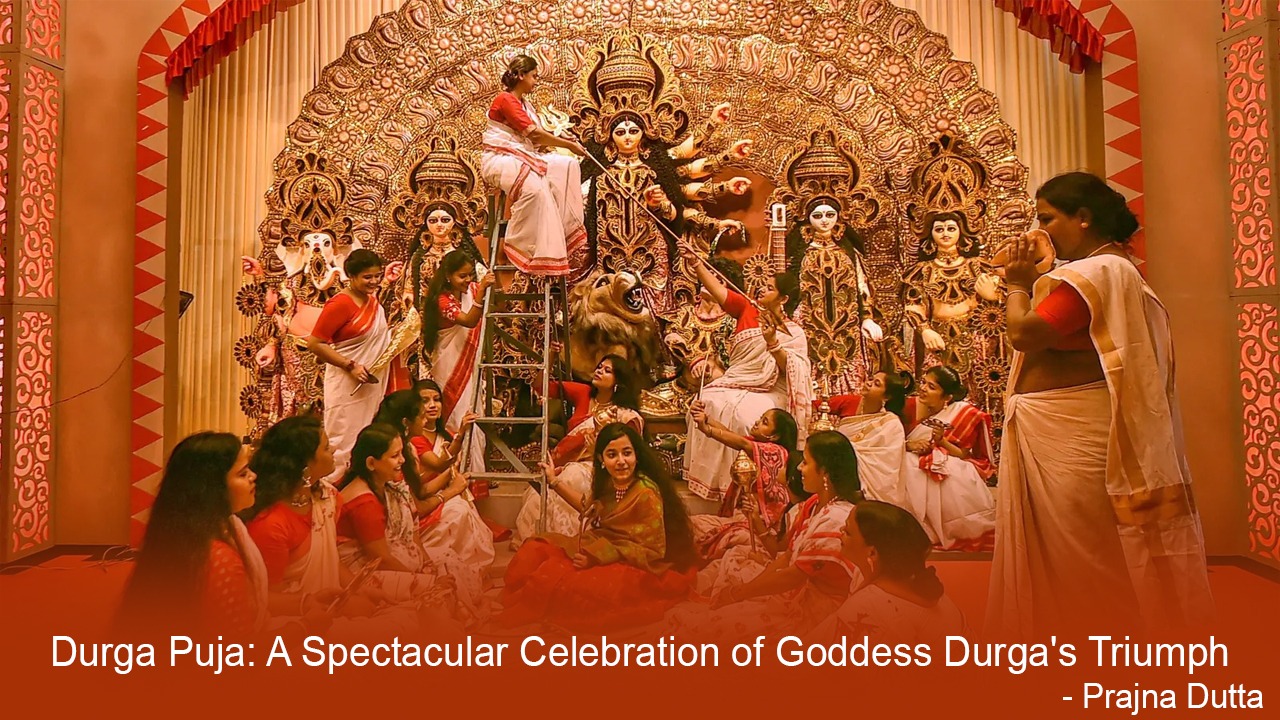Introduction:
Durga Puja, also known as Navaratri or Durgotsav, is one of the most vibrant and significant festivals celebrated by Hindus worldwide. This grand festival honors the supreme goddess Durga and her triumph over the buffalo demon, Mahishasura. With its elaborate rituals, mesmerizing decorations, artistic performances, and joyous revelry, Durga Puja truly embodies the essence of devotion, spirituality, and cultural heritage. Let's dive into the fascinating world of Durga Puja and discover why it captivates millions of people every year.
Historical and Mythological Significance:
The legend of Durga Puja dates back to ancient Hindu scriptures. According to mythology, when the gods were tormented by the formidable demon Mahishasura, they created Goddess Durga, an embodiment of divine feminine power, to vanquish him. The festival symbolizes the victory of good over evil, light over darkness, and righteousness over wickedness.
Preparations and Decorations:
Months before Durga Puja, communities across India and other parts of the world start preparing for the festivities. Skilled artisans meticulously craft magnificent clay idols of Goddess Durga and her entourage. These statues, adorned with intricate jewelry and vibrant clothing, are placed in beautifully decorated temporary structures called pandals. The pandals are often themed, showcasing various mythological stories or cultural motifs, providing a visual extravaganza for devotees and visitors.
Rituals and Worship:
Durga Puja lasts for nine nights and ten days, during which devotees observe strict fasting and engage in prayers and rituals. The festival begins with the ceremonious installation of the idols in the pandals, accompanied by the chanting of sacred hymns and the beating of drums. Elaborate rituals, known as "puja," are performed every day to honor the goddess. These rituals involve offerings of flowers, incense, fruits, and sweets, as well as the chanting of mantras and the recitation of sacred texts.
Cultural Extravaganza:
Durga Puja is not just a religious festival; it is also a celebration of art, culture, and community bonding. The pandals become the hub of cultural activities, featuring traditional music, dance performances, theater, and poetry recitations. People dress in their finest attire, and the streets come alive with processions, drummers, and enthusiastic revelers. The evenings are filled with joyous celebrations, as people participate in traditional dances like the energetic Dhunuchi dance and the graceful Sindoor Khela.
Feasting and Delicacies:
Food plays an essential role during Durga Puja, as devotees break their fast with sumptuous meals. Pandals often offer community kitchens known as "bhog," where volunteers prepare and distribute vegetarian meals to all visitors. Special delicacies like khichdi, luchi, alur dom, and shondesh are prepared and savored by everyone. The festival brings together people from diverse backgrounds, fostering a sense of unity and communal harmony.
Conclusion:
Durga Puja is more than just a religious festival; it is a kaleidoscope of colors, emotions, and cultural heritage. It represents the triumph of good over evil, and the devotion of millions towards the divine feminine power. The festival's grandeur, artistic expressions, and the spirit of togetherness make it an unforgettable experience for everyone involved. Durga Puja transcends religious boundaries, attracting people from various faiths and backgrounds who come together to witness the splendor and participate in the festivities.
The festival's significance extends beyond its religious roots. It showcases the rich cultural heritage of the region where it is celebrated. Artisans and craftsmen pour their creativity into crafting exquisite idols and intricate pandal decorations, blending traditional techniques with contemporary artistry. These artistic creations are not only a visual treat but also serve as a platform for social messages and storytelling.
Moreover, Durga Puja acts as a catalyst for economic growth. The festival generates employment opportunities for numerous individuals involved in idol making, pandal construction, decoration, and various other aspects. Local businesses thrive during this period, as the streets are filled with eager shoppers looking for new attire, accessories, and gifts. The economic impact of Durga Puja is substantial and contributes to the overall prosperity of the community.
Beyond the cultural and economic aspects, Durga Puja holds a deeper spiritual significance. It is a time for introspection, self-discipline, and seeking blessings from the goddess. Devotees engage in rigorous fasting and perform acts of charity, believing that their devotion and prayers will bring them spiritual enlightenment and blessings from the divine.
In recent years, Durga Puja has gained global recognition, attracting tourists from around the world who come to witness this grand celebration of faith and culture. Cities like Kolkata in India, where Durga Puja is particularly renowned, witness a massive influx of visitors during this time. The city transforms into a vibrant cultural hub, with an infectious energy permeating the air.
However, like many festivals, Durga Puja also faces challenges in adapting to changing times. Environmental sustainability has become a growing concern, especially regarding the use of non-biodegradable materials in pandal decorations. Efforts are being made to promote eco-friendly practices, such as using natural materials and promoting awareness about waste management.
In conclusion, Durga Puja stands as a glorious amalgamation of spirituality, art, culture, and community. It is a time when people come together to celebrate the triumph of good over evil while immersing themselves in the joyous festivities. Durga Puja offers a glimpse into the rich tapestry of Indian traditions and serves as a reminder of the enduring power of faith and unity.

Comments